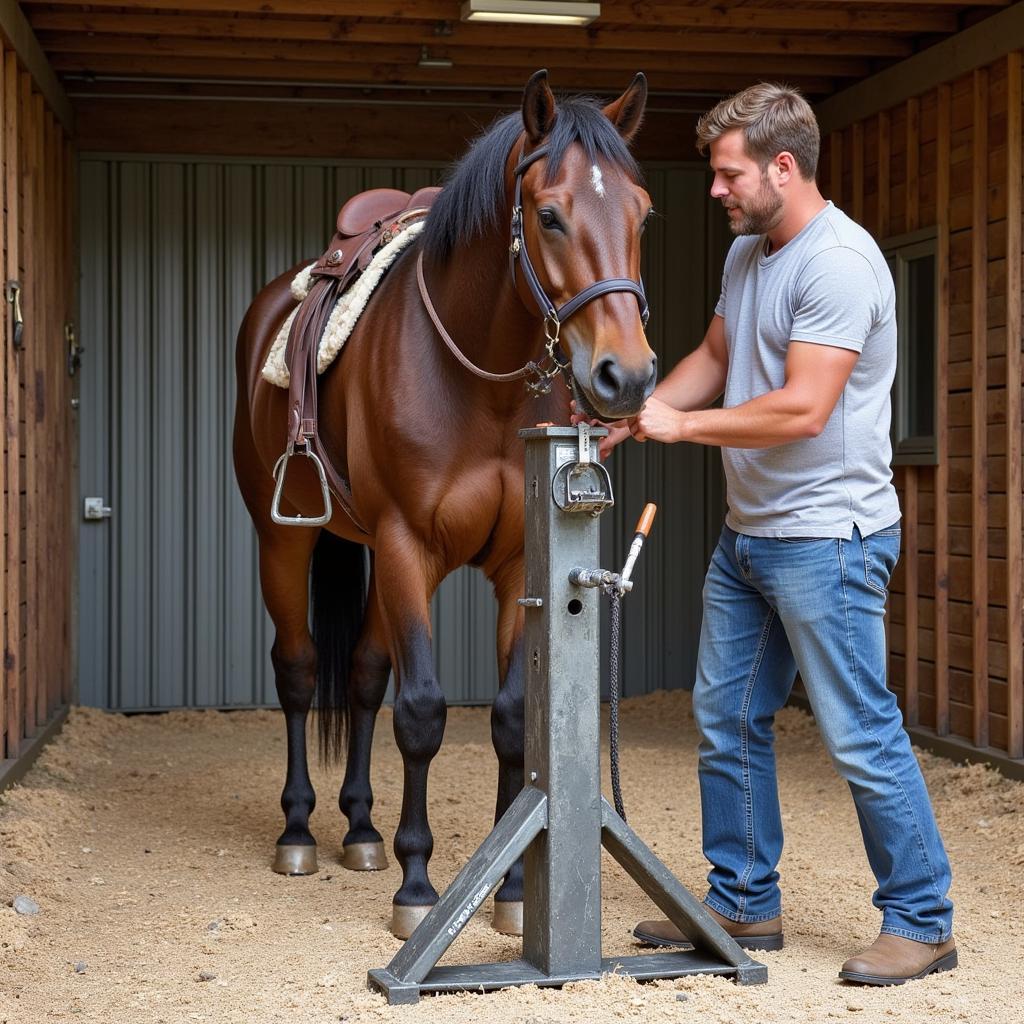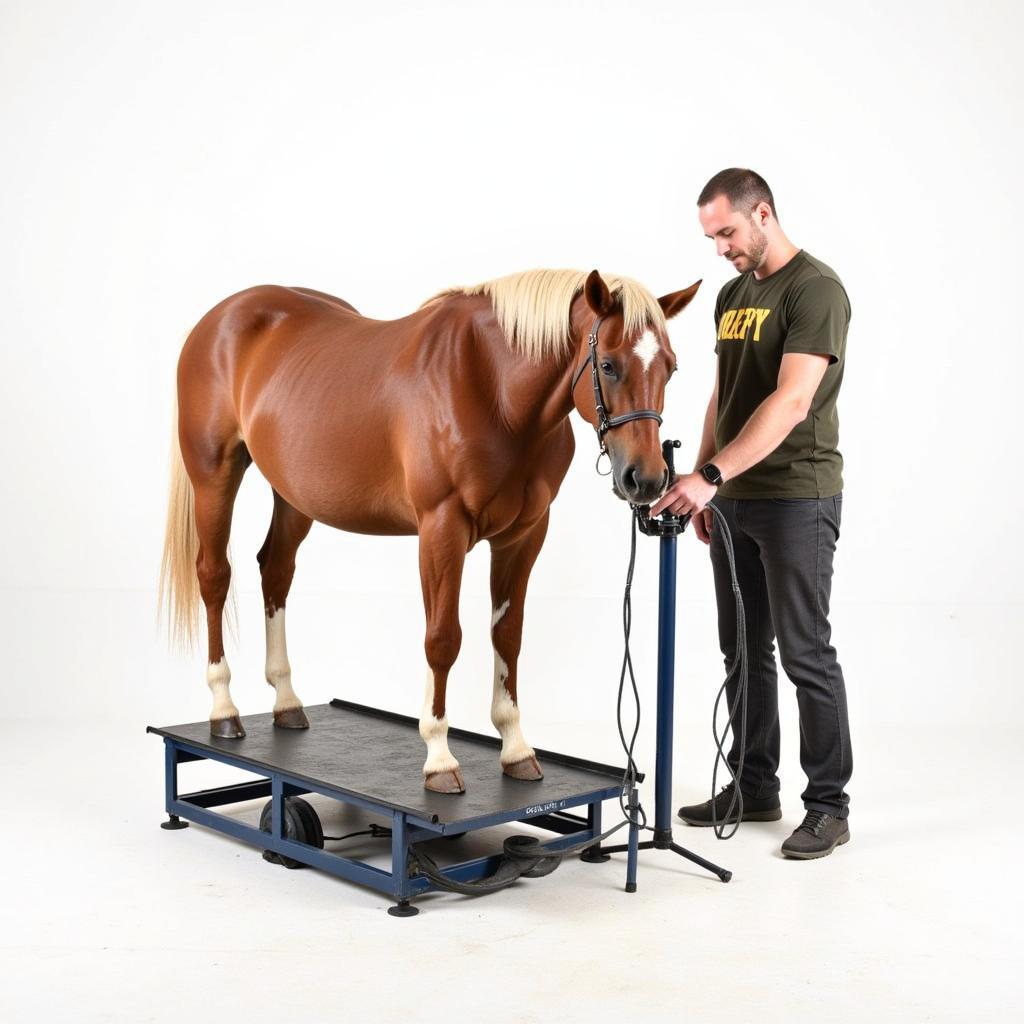A Horse Shoeing Stand is an essential piece of equipment for farriers and horse owners alike. It provides a safe and stable platform for the farrier to work on, allowing them to perform their tasks with greater precision and efficiency. Choosing the right horse shoeing stand can make a significant difference in the overall shoeing experience, impacting both the horse and the farrier.
 Farrier using a horse shoeing stand to shoe a horse
Farrier using a horse shoeing stand to shoe a horse
Types of Horse Shoeing Stands
Several types of horse shoeing stands cater to different needs and preferences. Understanding the various options available helps in selecting the best fit for individual requirements. Some popular types include:
- Portable Stands: These stands are lightweight and easy to transport, making them ideal for mobile farriers or those who travel to different locations.
- Stationary Stands: These heavier, more robust stands are designed for permanent installation in a farrier shop or barn. They often offer more features and stability.
- Adjustable Stands: Adjustable stands allow for customization in height and angle, accommodating horses of various sizes and breeds. This adaptability is particularly beneficial for farriers working with a range of horses.
- Rotating Stands: Rotating stands facilitate hoof trimming and shoeing by allowing the farrier to access the hoof from different angles without repositioning the horse.
Key Features to Consider
When choosing a horse shoeing stand, several key features are important to consider:
Stability and Durability
A stable stand is crucial for the safety of both the horse and the farrier. Look for stands made from high-quality materials like steel, ensuring durability and longevity. Ensure the stand has a wide base and non-slip feet to prevent tipping or movement during use.
Adjustability
An adjustable horse shoeing stand caters to horses of different sizes. This is beneficial for someone working with various horse breeds. Remember, what is the fetlock on a horse can vary in size.
Hoof Rest
A comfortable hoof rest is important to minimize stress on the horse’s leg. Look for stands with padded or contoured hoof rests that provide adequate support and prevent slipping.
Safety Features
Safety features, such as straps and chains, help secure the horse’s leg and prevent accidents. Some stands also feature quick-release mechanisms for emergencies.
Benefits of Using a Horse Shoeing Stand
Using a horse shoeing stand provides several benefits for both the farrier and the horse:
- Improved Ergonomics: The stand allows farriers to work at a comfortable height, reducing back strain and fatigue. This improved posture enhances efficiency and precision during shoeing.
- Increased Safety: A secure and stable stand reduces the risk of injury to both the horse and farrier during the shoeing process.
- Better Hoof Access: Stands provide improved access to the hoof, allowing for more precise trimming and shoeing. This meticulous work promotes healthy hoof development and function.
- Reduced Stress on the Horse: A comfortable and supportive stand helps to keep the horse calm and relaxed during the procedure, lessening the stress associated with traditional shoeing methods.
 Farrier working comfortably and safely using a shoeing stand
Farrier working comfortably and safely using a shoeing stand
“A well-designed horse shoeing stand is an investment in the well-being of both the farrier and the horse,” says Dr. Emily Carter, DVM, a leading equine veterinarian. “It promotes safer, more efficient shoeing practices, contributing to healthier hooves and a more comfortable experience for all involved.”
Maintaining Your Horse Shoeing Stand
Proper maintenance ensures the longevity and effectiveness of your horse shoeing stand. Regular cleaning and lubrication of moving parts are essential for smooth operation. Check for any signs of wear and tear, addressing them promptly to prevent further damage. Store the stand in a dry, protected area to minimize rust and corrosion. “Regular upkeep of your horse shoeing stand not only extends its lifespan but also ensures its continued safe and reliable performance,” adds John Miller, a certified farrier with over 20 years of experience.
In conclusion, choosing the right horse shoeing stand is a crucial decision for any farrier or horse owner. By considering the various types, features, and benefits, you can make an informed choice that improves safety, efficiency, and overall shoeing experience. Remember, investing in a high-quality horse shoeing stand is an investment in the health and well-being of your horses and the professionals who care for them. Learn about the external anatomy of a horse to understand more. Also, consider the things for a horse. If you notice horse shivers symptoms, consult a veterinarian.
FAQ
- What is the average lifespan of a horse shoeing stand?
- How often should I clean and lubricate my horse shoeing stand?
- What are the signs of wear and tear to look for on a horse shoeing stand?
- What are the different weight capacities of horse shoeing stands?
- Are there any specific safety certifications to look for when purchasing a horse shoeing stand?
- Can I use a horse shoeing stand for other hoof-related tasks besides shoeing?
- What are the price ranges for different types of horse shoeing stands?
For assistance, contact us at Phone Number: 0772127271, Email: [email protected] or visit our address at QGM2+WX2, Vị Trung, Vị Thuỷ, Hậu Giang, Vietnam. We have a 24/7 customer service team.